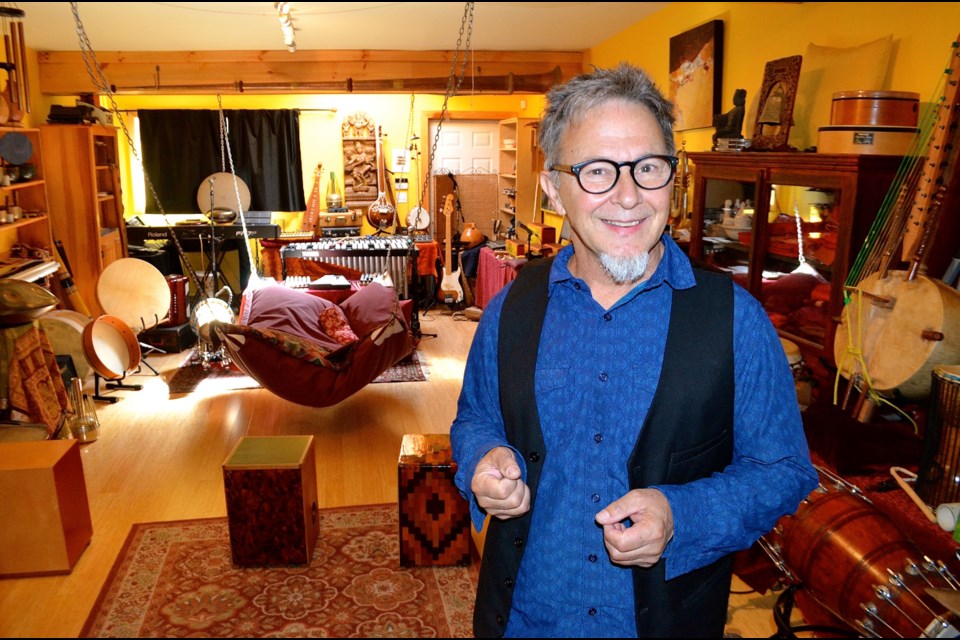Music has played an instrumental part in Gary Diggins’ life and career since he was a child, yet he concluded more than four decades ago that he didn’t want to be an entertainer.
“I was working in Detroit and got to play for people like Sly and the Family Stone and Alice Cooper,” said Diggins. “I warmed up for Bob Seger and Ted Nugent. It was a great scene but it is a hard lifestyle and I came to a point where I thought, is this really what I want to do for a life-long career – being a touring musician? The answer came back, no. I loved music, but I didn’t want to be an entertainer.”
He wasn’t yet 20, but he already felt a sense of destiny and a duty to serve the community and use his talents to help people.
“There is an old Latin term ‘Vocato’ from which we get the term vocation,” said Diggins. “I believe that music can call an individual to an artistic path. I feel that I was wired to really work as a community musician in that regard – to support people in their journey through change.”
It was a road to Damascus moment for Diggins but that’s not how he would have described it in 1971.
“When I was 19 years of age and opening up for Alice Cooper, I would never have said anything remotely like that.” he said with a grin.
Diggins sense of destiny would eventually lead him to an instrument-stocked studio at Silence in Guelph where he provides music therapy for people in periods of transition and where he has become a creative force in the local music community.
“We moved here exactly seven years ago,” he said. “I saw that everything I desired was right here in town in terms of collaboration and space to gather with other people. It was meant to happen.”
Diggins was born in Windsor in 1951, the middle child of three siblings. His father was a veteran of the Second World War who worked in human resources during the day and played jazz at night. Diggins was eight years old when the sound of jazz changed his life.
“I was leaning over a pool table at my uncles’ and I heard the classic sizzle of somebody putting on an l.p,” said Diggins. “It was Miles Davis’s Kind of Blue and the sound of Miles’ muted horn just reached out and spoke to my being. I asked my father, ‘what’s that instrument’ and he said, ‘that’s the trumpet’. He said, ‘a trumpet is too big for your hands and mouth so we will get you started on the cornet’. The cornet is still my foremost voice.”
Detroit was a Mecca for many of the biggest acts in music at the time and Diggins was in the middle of it.
“I got to see a lot of great performers in Detroit,” he said. “When I was 15 I got to see Jimi Hendrix live and I got to see Cream there when I was 19.”
By the time he was in his late teens his seven-piece horn band Blues Train was backing rockers such as Iggy and the Stooges and MC5 and opening shows for jazz legends such as John “Mahavishnu” McLaughlin, Tony Williams and Larry Young then Diggins decided to shift course.
“I took a year off and went out into the country and I ate well,” he said. “I first took up meditation then I decided to go back to school and study psychology and the rudiments of music therapy.”
He moved to Toronto where his music and therapy work were influenced by the burgeoning improvisational scene and the cultural diversity.
“Particularly in African culture, music is appreciated not just as an art form but really as a spiritual practice,” he said. “I really found my ears widened at that point and the collaborations were so thrilling because it was like sonic soup. Somebody brought a different ingredient that I wasn’t familiar with but it would pull something different out of me.”
He authored the book Tuning the Eardrums – Listening as a Mindful Practice and has been invited to regions all over the world including Rwanda where his music therapy was used to help women process the trauma of genocide and to Israel where he helped adolescent boys from Ramallah and Jerusalem communicate peacefully through music.
Diggins married dancer Catherine Kormendy in 2001 and they moved to Guelph in 2012. They have a son and daughter together and Diggins has twin sons from a previous marriage.
He has been involved in countless musical projects and collaborations through Silence and the wider Guelph community since he arrived and continues to focus his musical talents on helping people.
“I work with an individual often using the soundscapes that I create as a way of supporting them through the internal journey they are going through,” he said. “I am amazed at how resilient we are if we have tools to put wind back in our sails. Music does that. Music is medicine.”
The ever-growing collection of instruments in his studio are both tools for his work and symbolic souvenirs from his personal journey.
“A lot of these instruments hail from places where I traveled,” he said. “All these bowls came from my travels in India and some of these African instruments come from places where I worked. There are stories and relationships attached to them.”
Diggins has taken time to listen and appreciate the silent spaces between the beats and is proof that you don’t have to make a lot of noise to have a successful music career.
“Miles Davis said something way back in the day, ‘It’s not where you play. It’s where you don’t play.’ I think musicians come to that understanding later on in life. The silence can be as beatific as the playing.”



